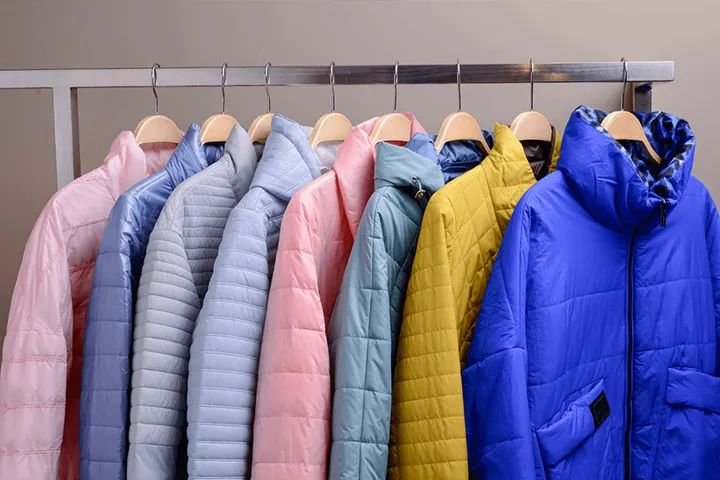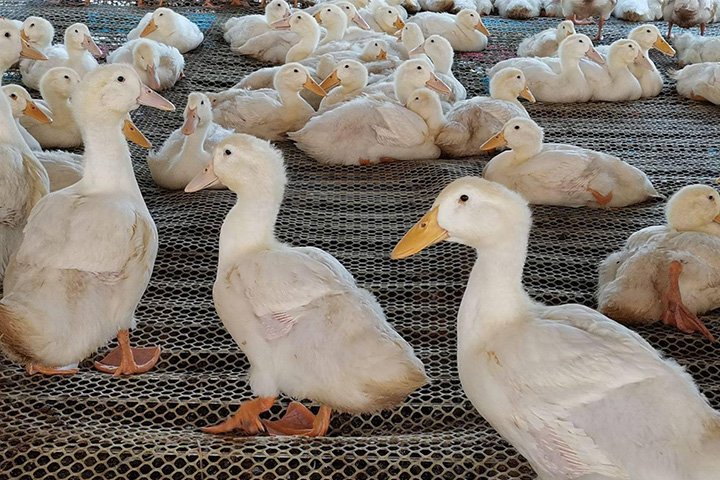Cn-down > Domestic news > News content
2024-07-22 来源:金绒 浏览量:1126
Summary
The market conditions in the 29th week of 2024 (July 15-21) were generally stable.

As the summer approaches, the quality of raw wool continues to decline, and washing factories are reluctant to buy. However, recent order fairs have been held frequently, which may make the finished down market more active, thereby improving the current profit dilemma of processing factories. At present, it seems that clothing companies are still very cautious in placing orders, and big brands are particularly willing to bargain.
Looking back over the past few years, it has been almost normal for down prices to fall in July, and as the current market has been in a long-term downturn, more and more people are bearish. However, the shortage of raw material down supply has not improved, so the fundamentals of the market that are easy to rise but difficult to fall have not changed.
With the arrival of June, the export of down products has officially entered its peak season. Down bedding is expected to see growth in the third quarter due to the seasonal demand of European and American consumers. Customs data show that the export of "processed feathers, down and their products" has shown a positive trend again in June.
Good News This Week
The General Administration of Customs announced on July 12 that the total value of our country's import and export of goods in the first half of the year was 21.17 trillion yuan, a year-on-year increase of 6.1%. Among them, exports were 12.13 trillion yuan, an increase of 6.9%; imports were 9.04 trillion yuan, an increase of 5.2%; and the trade surplus was 3.09 trillion yuan, an increase of 12%.
In June, the total value of imports and exports was 3.67 trillion yuan, a year-on-year increase of 5.8%. Among them, exports were 2.19 trillion yuan, an increase of 5.8%; imports were 1.48 trillion yuan, a decrease of 0.6%. The trade surplus was 703.73 billion yuan. In US dollars, exports were 307.85 billion US dollars, a year-on-year increase of 8.6%, the highest growth rate since April 2023.
In the first half of the year, our country's import and export scale exceeded 21 trillion yuan for the first time in the same period in history; the growth rate of imports and exports accelerated quarter by quarter, with a growth of 7.4% in the second quarter, 2.5 and 5.7 percentage points higher than the first quarter and the fourth quarter of last year respectively, and the positive momentum of foreign trade was further consolidated.

In June, our country's top three export markets were the Association of Southeast Asian Nations, the European Union and the United States. Among them, exports to ASEAN increased by 15% year-on-year, exports to the EU increased by 4.1% year-on-year, and exports to the United States increased by 6.6% year-on-year.
Analysts pointed out that global trade is in a recovery phase this year, driven by the unexpected resilience of the US economy, the upward cycle of the global electronics industry, and the expectation of interest rate cuts by the European and American central banks. As of June, the JPMorgan Chase Global Manufacturing PMI Index has been in the expansion range for six consecutive months, which means that the current external demand is still resilient and the momentum of export growth is expected to continue in the short term.
In addition, in the first half of the year, our country's total exports of textiles and clothing to the world amounted to 1,017.1 billion yuan, an increase of 4.7%. Among them, textile exports amounted to 492.67 billion yuan, an increase of 6.5%; clothing and clothing accessories exports amounted to 524.43 billion yuan, an increase of 3%. In June, textile exports amounted to 87.02 billion yuan, a year-on-year increase of 5.7%; clothing exports amounted to 107.61 billion yuan, a year-on-year decrease of 1.8%.
source | 金绒采编自海关总署、界面新闻
On July 11 local time, the Climate Prediction Center of the National Oceanic and Atmospheric Administration (NOAA) reported that the probability of La Niña occurring between August and October 2024 is 70%, and the probability of continuing until the Northern Hemisphere winter of 2024-2025 (November to January of the following year) is 79%.
Compared to last month, the most recent IRI probability model pushes the onset of La Niña back to September-November 2024, while NOAA’s forecast team, while also seeing a delay in the development of La Niña, expects the transition to occur earlier (August-October).
Multiple models agree that a La Nina event is likely, though this time the intensity of the event will be reduced. Current forecasts put the probability of this La Nina event reaching an informal "moderate" peak at about 50%.

In the winter of La Niña, the cold waves and cold air activities affecting our country are usually more frequent and stronger than in normal years. This will lead to a higher probability that the temperature in most parts of central and eastern our country will be lower than the same period of normal years. The stronger the "intensity" of the La Niña event, the greater the possibility of its expected impact.
In summary, the El Niño-Southern Oscillation (ENSO) is expected to remain neutral in the coming months, while La Niña is expected to emerge from August to October and continue to affect the northern hemisphere winter of 2024-25.
In addition, meteorological experts pointed out that this round of La Nina phenomenon is "definitely likely" to last for two years, because from past historical data, the stronger the previous El Nino phenomenon, the longer the subsequent La Nina phenomenon will last.
source | 金绒采编自NOAA、ENSO博客
According to Chinese customs data, from January to June 2024, the total export value of "processed feathers, down and their products; artificial flowers; human hair products" was RMB 3,798,779 million, a cumulative increase of 8.6% over the same period last year.
The total import value of this commodity category from January to June was RMB 518,085 million, a cumulative increase of 19.7% over the same period last year. The import value continued to be high.

In June this year, the total export value of "processed feathers, down and their products; artificial flowers; human hair products" was RMB 678,811 million, an increase of 8% year-on-year and 2% month-on-month from May; the total import value was RMB 78,669 million, an increase of 9% year-on-year and 1% month-on-month from May.
At present, it seems that "processed feathers, down and their products; artificial flowers; human hair products" have shown growth momentum in international trade in the first six months of 2024. Although there was a decline in May, the trend in June has improved again.
source | 金绒采编自海关总署
It is understood that at the end of last year, the wholesale price of a pound of dagger feathers was about 200 yuan, including about 600 pieces of raw materials, which means that one dagger feather cost less than 0.4 yuan. As of now, the price of a pound of dagger feathers has exceeded 300 yuan, an increase of 50%, and there is a trend of continued increase.
"The purchase price of lionhead goose feathers in Shantou area has risen from 20-30 yuan per goose to 70 yuan now." Professor Jia Rumin of Binhai Agricultural College of Guangdong Ocean University said that the production capacity of ducks and geese has indeed decreased significantly, but the increase in feather prices seems to have exceeded the decline in waterfowl production capacity.

"In the past two years, some new diseases have appeared in ducks and geese, such as gout and reovirus. Affected by the diseases, the survival rate has decreased, which has a great impact on waterfowl farming." Professor Huang Shujian of Foshan University introduced that in addition to diseases, there are also influences of environmental factors, and the market conditions in the past few years have not been very good, so the breeding volume has declined sharply.
He introduced that, taking Guangdong as an example, in the past, about 320 million ducks and 80 million geese were slaughtered, adding up to more than 400 million. Now the number of ducks and geese slaughtered is about 300 million, a decrease of about 20%. Guangdong consumes more than 500 million waterfowl throughout the year, of which 60% are produced and sold by itself, and 30%-40% are from outside the province. This shows that there is still a gap of about 100 million.
source | 南方农村报
Bad news this week
In June this year, the monthly sales data of down jacket brand YaYa in more than ten authorized live broadcast rooms on the Douyin platform were all over 10,000 pieces, but does YaYa really have such a huge backlog of inventory? The answer is obvious.
Selling winter clothes in summer has evolved from a simple business operation of clearing inventory, freeing up storage space, and accelerating cash flow to an e-commerce marketing strategy for the winter clothing industry. Selling winter clothes in summer seems to have evolved into a business behavior with more extended meanings.
This is not only true for down jackets, the winter home textile industry has also started a wave of "off-season sales" this year. In the Douyin live broadcast room of a home textile factory store in Nantong, a winter children's quilt that sold 30,000 pieces in the winter of 2023 achieved another sales of 10,000 pieces in June this year.

It is understood that the factory originally had only more than 300 out-of-stock items. Unexpectedly, after the live broadcast room was launched, the product broke through the siege among a large number of summer quilts and mats. After being "sold out in seconds", many consumers asked when it would be put on the shelves again? When will the full range be available? The factory took advantage of the victory to expedite production and finally sold nearly 10,000 pieces.
However, when you click on the original winter link, you will find that the summer promotional item is only about 30 yuan cheaper than the regular-priced item. The discount for the so-called "clearance sale" is far lower than you might imagine.
In winter, if a consumer buys a down jacket worth 300 yuan, they will question whether the filling is good or the warmth is not good. In summer, if a consumer buys a down jacket worth 300 yuan, they will convince themselves that it is a clearance sale. In the imagination, off-season consumers should be price-sensitive people, but now they are more like impulse shoppers.
source | 胡晶 中纺联流通分会
The "dog days" with heat as its signature have begun! This year, the dog days began on July 15, and the temperature is 40 days longer. Historical observation data shows that the highest proportion of high temperatures in this period of time is common in the Jianghuai and Jiangnan regions, and the "dog days" are truly hot.
According to the forecast of the Central Meteorological Observatory, the temperature in Jiangnan and most of South China will fluctuate between 35 and 39 degrees Celsius in the near future, and the local temperature may even exceed 40 degrees Celsius. Wide range, long duration and high temperature are the prominent features of this round of high temperature weather.
Due to the current seasonal factors, it is more difficult to raise contract ducks in the northern region, and the production rate of medium and large-sized white strips is getting lower and lower. Mid-to-late June was once considered to have a downward turning point, but judging from the recent shipment performance, the market has once again shown a sustained upward rhythm.

After all, July and August are the golden seasons for duck products without exception, and the recent wholesale market shipments have shown that both production and sales are booming. Moreover, the price of live pigs is still rising, and the substitution effect of duck products will continue to strengthen.
The current national average daily output of commercial seedlings is estimated to be 11.8 million, which is stable compared with last week; and the national white-feathered parent-generation breeding duck inventory last week was about 260,000 units, an increase of 1,100 units from the previous month. The number of breeding ducks increased, and the number of newly produced breeding ducks also increased slowly, corresponding to the stable trend of commercial seedlings in mid-July.
From the overall situation of the monitored samples, the cost of slaughtering in July continued to rise compared with June, while the number of slaughtered animals remained basically stable compared with June. Although there was a decrease of about 1-5% at many sample points, the number of local sample points increased instead of decreased, resulting in the total amount remaining basically stable.
source | 金绒综合自信得科技、佳合食品集团、水禽行情网
News Situation
This week's news has more positives than negatives.
According to the data from the General Administration of Customs, the total value of our country's import and export of goods increased in the first half of the year, especially the strong performance of exports. For the down industry, this means that the external market demand is still strong, and the sales volume of down products in the international market is expected to maintain steady growth.
The US NOAA predicts that there is a 70% chance of La Niña occurring between August and October 2024 and that it may continue into the winter. La Niña usually causes frequent cold snaps in our country in winter and lower temperatures than usual, which will increase demand for thermal insulation products.
Although off-season sales of down jackets can extend the sales season, clear inventory and attract consumers to a certain extent, off-season sales may also overdraw consumers' purchasing demand in advance, thereby reducing sales in the autumn and winter seasons, and may even lead to more backlogs of unsold goods.
 热门排行
中国三大羽绒生产基地之—广东吴川
全球最奢侈羽绒服排行
一件羽绒服需要多少只鸭子的羽绒?
飞丝是什么?能代替羽绒?别被骗了,三种方法让你告别假羽绒服!
2017羽绒原料价格一路上涨,究竟为何?
你的羽绒服为什么钻绒?涨知识了
羽绒被的价格一般是多少 通过成本看羽绒被价格
中国羽绒服四大品牌调查:到底谁才是最强王者?
羽绒金网:羽毛、羽绒、毛绒计价
《羽绒羽毛》、《羽绒羽毛检验方法》新版标准发布,2017年7月1日实施
热门排行
中国三大羽绒生产基地之—广东吴川
全球最奢侈羽绒服排行
一件羽绒服需要多少只鸭子的羽绒?
飞丝是什么?能代替羽绒?别被骗了,三种方法让你告别假羽绒服!
2017羽绒原料价格一路上涨,究竟为何?
你的羽绒服为什么钻绒?涨知识了
羽绒被的价格一般是多少 通过成本看羽绒被价格
中国羽绒服四大品牌调查:到底谁才是最强王者?
羽绒金网:羽毛、羽绒、毛绒计价
《羽绒羽毛》、《羽绒羽毛检验方法》新版标准发布,2017年7月1日实施
 推荐阅读
“吴川力量”助中国羽绒接轨世界
中国三大羽绒生产基地之—广东吴川
中羽协第二期新国标培训班 在“羽绒之乡”广东吴川成功举办
羽绒之乡:贵港桥圩镇将打造旅游休闲特色小镇
广西贵港桥圩镇:打造中国羽绒休闲旅游特色小镇
羽绒金网:羽毛、羽绒、毛绒计价
羽绒别急着收 中央气象台发布寒潮蓝色预警 部分地区降温超12℃
上海消保委检测 千元鹅绒被用鸭毛绒填充
冻哭丨降温10℃!鸡年首个寒潮预警来袭,你准备好了吗?
传统羽绒产业如何实现转型升级?四川玉泉镇产业集群发展
推荐阅读
“吴川力量”助中国羽绒接轨世界
中国三大羽绒生产基地之—广东吴川
中羽协第二期新国标培训班 在“羽绒之乡”广东吴川成功举办
羽绒之乡:贵港桥圩镇将打造旅游休闲特色小镇
广西贵港桥圩镇:打造中国羽绒休闲旅游特色小镇
羽绒金网:羽毛、羽绒、毛绒计价
羽绒别急着收 中央气象台发布寒潮蓝色预警 部分地区降温超12℃
上海消保委检测 千元鹅绒被用鸭毛绒填充
冻哭丨降温10℃!鸡年首个寒潮预警来袭,你准备好了吗?
传统羽绒产业如何实现转型升级?四川玉泉镇产业集群发展